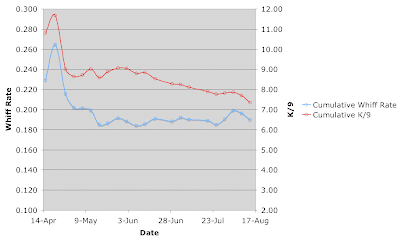a) He really likes to throw outside fastballs, both to lefties and righties
b) For some reason, he throws harder against righties
c) I feel more confident in his abilities when he's facing righties
What I see/remember and what the facts are frequently differ, so I decided to check out some pitch data on Chamberlain this year to see if what I thought meshed with reality. First, the pitch locations. This chart shows the approximated frequencies (smoothed by Excel trendlines) of Chamberlain's four-seamer location to righties (blue) and lefties (red).

The peaks of both curves are both on the outer half of the plate. This is pure speculation - Chamberlain led the majors in hit batsmen last year with 12, and quite possibly got a reputation for being a head-hunter after his really weird beanball thing with Kevin Youkilis (there were also minor incidents with Jason Bay and Evan Longoria last year). Is it possible that he's trying to shake that label by pitching inside less? Well, before putting any stock in that whatsoever, I looked back at his 2009 data to see if there were similar trends among pitch location. Turns out there were, though they were less exaggerated:
Maybe there's something to it. Chamberlain hasn't hit anyone this year, and he's one of only six relievers with a minimum of 50 IP with that distinction. Moving on ...
I had a suspicion that Joba was throwing his hardest against same-handed batters. Whatever the reason, that is in fact the case:
+--------------+--------------+
|FF mph to RHB-|FF mph to LHB-|
+----------------+------------+
|----94.97-----|----94.02-----|
+--------------+--------------+
This leads in nicely to my final point about Chamberlain - I've just been feeling better recently when he faces right-handers. But why? Here are a few splits.
+------+-----+-----+--------+------------+------------+------------+
|------|K/9--|BB/9-|GB Rate-|Whiff Rate--|Chase Rate--|Zone Rate---|
+------+-----+-----+--------+------------+------------+------------+
|vs RHB|9.31-|2.79-|.506----|.240--------|.323--------|.523--------|
+------+-----+-----+--------+------------+------------+------------+
|vs LHB|9.78-|3.52-|.484----|.182--------|.282--------|.391--------|
+------+-----+-----+--------+------------+------------+------------+
Alright, but those averages are skewed by the different pitch mix against righties and lefties:
+----------+------------+------------+------------+------------+
|----------|Pitch%------|Whiff Rate--|Chase Rate--|Zone Rate---|
+----------+------------+------------+------------+------------+
|FF vs RHB-|.591--------|.138--------|.288--------|.566--------|
+----------+------------+------------+------------+------------+
|FF vs LHB-|.722--------|.078--------|.211--------|.407--------|
+----------+------------+------------+------------+------------+
|SL vs RHB-|.372--------|.366--------|.384--------|.453--------|
+----------+------------+------------+------------+------------+
|SL vs LHB-|.157--------|.432--------|.615--------|.361--------|
+----------+------------+------------+------------+------------+
Now we're getting somewhere. Chamberlain has better control against right-handers, as evidenced by the lower walk rate and higher strikezone rate for the fastball. The whiff rate for the fastball is much better to righties. Is that directly caused by the better velocity? And is better velocity due to being in more pitcher's counts? These are questions that are tough to answer, particularly given the small sample sizes. The slider looks like a more effective pitch to lefties for some reason, but he only goes to is 16% of the time - again, this is probably related to worse control. Maybe the pitch's effectiveness against lefties is due to the limited sample? Would being in hitters' counts more make him go to the slider more? That's a lot of questions that I don't really have answers to. That's for Chamberlain and Jorge Posada to figure out.
So, in conclusion, it looks like there actually was something to those three observations, but trying to rationalize them can get very confusing ...
Data is from MLBAM and Fangraphs.













